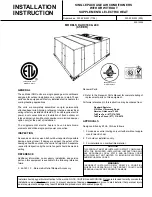
7
English
AT THE START OF OPERATION AND AFTER
DEFROST OPERATION
•
A warm air circulating system is employed, and
therefore it takes some time until the entire room
is warmed up after the start of operation.
•
The indoor fan runs to discharge a gentle wind
automatically until the temperature inside the air
conditioner reaches a certain level. At this time,
the remote controller displays “
”. Leave it
as it stands and wait for a while.
(The remote controller displays the airflow rate
that is set.)
•
The air discharge direction becomes horizontal to
prevent a draft of cool air to the inhabitants. (The
remote controller will display the set air discharge
direction.)
DEFROST OPERATION (Frost removal oper-
ation for the outdoor unit)
•
As the frost on the coil of an outdoor unit increase,
heating effect decreases and the system goes
into DEFROST OPERATION.
•
The indoor unit fan stops and the remote control-
ler display shows “
”.
With the wireless remote controller, the warm air
stops, and the DEFROST OPERATION lamp for
the light receiving unit indicator lights. (The
remote controller displays the airflow rate that is
set.)
•
After 6 to 8 minutes (maximum 10 minutes) of
DEFROST OPERATION, the system returns to
HEATING OPERATION.
•
The air discharge direction becomes horizontal.
(The remote controller displays the airflow direc-
tion that is set.)
•
When the operation is switched to the HEATING
OPERATION during or after the DEFROST
OPERATION, white mist comes out from the air
outlet of the outdoor unit.
(Refer to “
VII.
” on page 13.)
•
A hissing and “Shuh” sound may be heard during
this particular operation.
Regarding outside air temperature and heat-
ing capacity
•
The heating capacity of the air conditioner
declines as the outside air temperature falls. In
such a case, use the air conditioner in combina-
tion with other heating systems.
(When a combustion appliance is used, ventilate
the room regularly.)
Do not use the combustion appliance where the air
from the air conditioner is blown directly toward it.
•
When the warm air stays under the ceiling and
your feet are cold, we recommend that you use a
circulator (a fan to circulate the air inside the
room). For details, consult your dealer.
•
When the indoor temperature exceeds the set
temperature, the air conditioner discharges a
gentle breeze (switches to whisper mode). The air
discharge direction becomes horizontal. (The
remote controller displays the airflow rate and air-
flow direction that are being set.)
[CHARACTERISTICS OF THE PROGRAM
DRY OPERATION]
•
This operation lowers the humidity without lower-
ing the indoor temperature. The indoor tempera-
ture when the operation button is pressed will be
the set temperature. At this time, the airflow rate
and temperature are set automatically, so the
remote controller does not display the airflow rate
and set temperature.
To efficiently lower the indoor temperature and
humidity, first lower the indoor temperature using
the COOLING OPERATION, and then use PRO-
GRAM DRY OPERATION. When the indoor tem-
perature is lowered, air discharge from the air
conditioner may stop.
•
After continued operation at a downward airflow
direction, operate the air conditioner using a dif-
ferent direction setting for a period of time to pre-
vent condensation on the airflow flaps. (The
remote controller displays the airflow direction
that is set.)
•
If the PROGRAM DRY OPERATION is used
when the indoor temperature is low, frost forms
the heat exchanger of the indoor unit. In this case,
the system automatically switches to DEFROST
OPERATION for a while.
[SOUND PRESSURE LEVEL]
•
Sound pressure level is less than 70 dB(A).
AIRFLOW DIRECTION ADJUST
•
There are 2 ways of adjusting the airflow direc-
tion.
(When the operation stops, the airflow flaps at the
air outlet (vertical airflow direction adjustment
flaps) close automatically.)
A. Up and down direction
B. Left and right direction
4PEN465287-1C.book Page 7 Thursday, March 23, 2017 2:47 PM




































